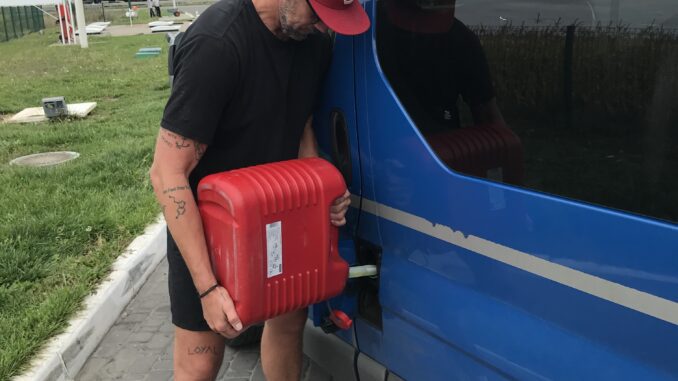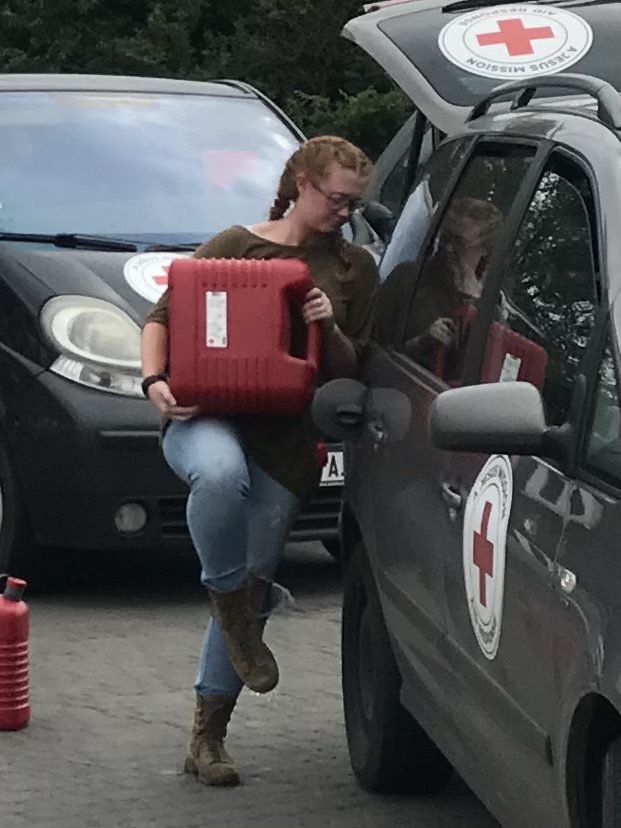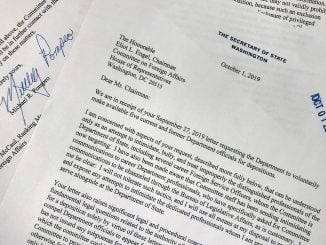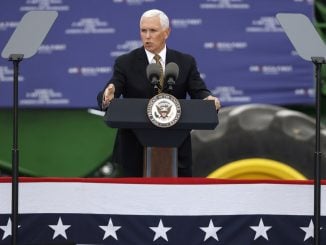
Shortly after 4:30 A.M., Romanian time, the GPS instructs us to turn left and we find ourselves at the end of a line of cars, waiting at a railroad crossing.
The lights are flashing, and the gate is down, but there is no train in sight.
Our walkie talkie crackles.
“We had to wait 20 minutes one time,” came a voice from one of the vans behind us.
After a brief discussion on the radio, we decide to go for it. The convoy of vans, with us in the lead, pull out of line and drive up the oncoming traffic lane, zipping around the crossing arm.
That’s when a bright light from our immediate left illuminates the early morning darkness, and we hear a loud whistle and the roar of a train, passing inches from our front bumper, as we sit in the wrong lane, on the wrong side of the divider.
“That would’ve been a quick ending to the trip,” came a voice from the middle van. Before we can respond, the crossing arm is rising, and we are off, ignoring more traffic rules as we try to get to a war zone as fast as we can.
The vans are part of a relief effort for Ukrainian refugees left in the war-torn country, sponsored by the worldwide missionary group A Jesus Mission. Since February, volunteers have been driving van loads of supplies into Ukraine from a base of operations 20 hours away, in Romania.
To a person, members of the group are confident that they are doing the Lord’s work, and He will protect them from danger. And they drive like it. They’ve been right so far, although the vans are not as lucky, scarred with near misses. Two of the vans are in the shop, because a driver—in the only automatic transmission vehicle the group has—accidentally rear-ended the van in front of him in the convoy, taking both of them out of commission.
That driver is the one I’m replacing on this trip, although he swears it’s not due to the accident.
A third van was deemed unable to make the trip, and the three vans we’re driving have side-view mirrors duct taped on and a variety of dents, scratches and cracked glass. By the time we reach our destination, the “check engine” light will be on in two of the three.
There have also been broken axles, rims and wheel springs as the vans encounter the hole strewn Ukrainian roads. Some of the deadly obstacles are “craters” from war damage, while others are just natural wear and tear that haven’t been a priority for the Ukrainian government to fix.
“Someone always seems to come along to help us,” a team member says. “We’ve had mechanics do the work for free. Once they find out what we’re doing, they want to help us.”
Just another example of the Lord providing on this voyage to help the Ukrainian people.
The trip into the country is a wild Cannonball Run of a cross-country race. We speed through small Romanian towns that are still asleep and knife through traffic on the highway. When I took my shift at the wheel, we were going a steady 80-plus miles an hour while trying to weave through traffic and topping 100 when we got into the clear.
The convoy keeps in constant communication by walkie talkie, and the lead van lets the trailing vehicles know when it’s safe to pass, saying, “Clear after the red truck” or “You have a 15 second window.”
As I was told when given the van keys for my shift, “When the lead driver tells you it’s clear, you GO.” It doesn’t matter if it’s a solid no-passing line or a blind curve—you trust your team and put the hammer down.

“That’s the toughest part for new drivers,” our team leader, Shannon, a heavily tattooed, 47-year-old former preacher, says. “To trust that, if your lead car says its safe, even if you can’t see it, it’s safe.”
I’m one of those new drivers, and I can’t tell which part is the toughest—the blind passing, the high velocity, the fact that I’m driving a stick for the first time in more than 25 years, which, other than Shannon, was before anyone on the team was born. I borrowed a friend’s Jeep for a refresher course in a mall parking lot before leaving. I didn’t care about getting from second to third or third to fourth—my goal was simple: “If bombs are falling and we have to go, I don’t want to stall it.”
(I do stall it. A lot. Including at a military checkpoint. By the time I get it moving and reach the soldier, he waves me on with annoyance, I’m sure saying, “Whatever you do, don’t come to another stop,” in Ukrainian.)
They show me how to “create a third lane” by putting your emergency flashers on. Our vans are marked with red crosses, as humanitarian aid vehicles, and with the blinkers on, we can be confused for an ambulance as we speed toward a car from behind. They’ll usually try to get out of our way, or at least allow us to straddle the center line, with two wheels in each lane—creating a non-existent third lane for passing.
Supply lines are improved in Ukraine, but still not dependable, especially as we get closer to the fighting. So we bring our own gas, in cans in the back of each van, making the prospect of an accident even more intimidating.
The driving isn’t reckless showboating, however. There’s a legitimate reason for these vehicles to be hurrying to do their work, just like a fire truck or paramedic. And, other than the high speeds, and the ill-advised train dodge, there aren’t many risky moves—no tailgating or playing chicken with oncoming traffic. Even if the vans are passing on a blind curve, they’re doing it after someone has checked to make sure nothing is coming.
“We drive hard,” Shannon admits. “The way I explain it is it’s a series of dominoes. The longer it takes us to get there, the less sleep we get. And that means we’re less rested for tomorrow, when we go into the area where the war is going on.”
“The longer it takes,” he concludes, “the less we can do.”
The method has benefits that are quickly tangible. Two hours into the trip, the lead van proudly announces that we’ve already cut a half hour off of our GPS estimated arrival time, and we end up making the drive to the border—calculated by Google Maps at five and a half hours—in just over four.
So we rocket through Eastern Europe in darkness, radios in tow, heading toward danger as fast as we can go.



